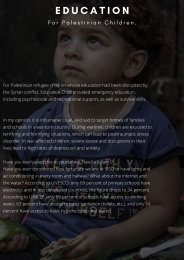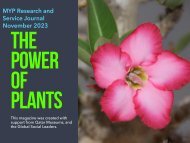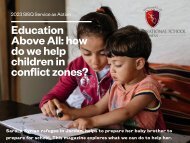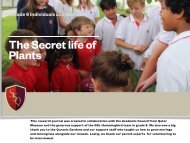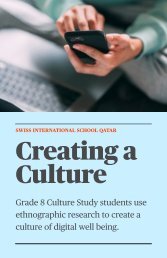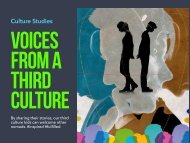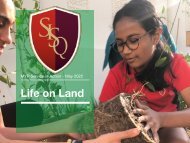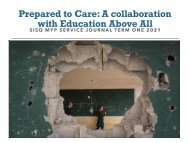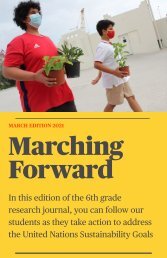Be a Hummingbird
Welcome to the second edition of the 6th graders research journal where we find out more about the action that they are taking to protect the planet.
Welcome to the second edition of the 6th graders research journal where we find out more about the action that they are taking to protect the planet.
Create successful ePaper yourself
Turn your PDF publications into a flip-book with our unique Google optimized e-Paper software.
2ND EDITION OF 6TH GRADE RESEARCH JOURNAL
Be a Hummingbird
Using the National Geographic Geo-Inquiry
process, our students are using their ISQH
investigations to create service learning action
research projects and saving the planet at the
same time.
Be A Hummingbird
2021 2nd Edition of ISQH research
journal
By 6th grade
What is a hummingbird - and why are the 6th
graders obsessed with them? ................................... 4
Let’s Find Ways to Attract Our Pollinators by Alya . 6
Robotic Bees by Ayaan ............................................ 12
A response to Ayaan by Salma ............................... 15
The importance of Bees in Islam by Ahmed ......... 21
Do we actually need flies? By Bisher
..................... 26
How do we create a biodiversity garden at SISQ?
by Soundus ............................................................... 33
Hummingbird Heroes .............................................. 39
What is a hummingbird - and why are
the 6th graders obsessed with them?
When our 6th graders were
learning about permaculture with
Papy Michel, he told them a story
from the Native American people
that had a profound effect not just
on our class but on some of the
greatest ecologists alive today.
Here is the English version as told by Pierre Rabhi (the
founder of The Hummingbird Movement”).
The tale goes as follows:
‘’One day, there was a huge forest fire. All the
terrified animals helplessly watched the disaster.
Only the hummingbird decided to take action,
going to get a few drops of water in its beak to
throw them on the fire. After a moment, the
armadillo, annoyed by his helpless actions, said to
him: "Hummingbird! Are you out of your mind? Do
you think it is with these drops of water that you will
extinguish the fire?
"I know that I am small and can only do a little”,
answered the hummingbird, but I have to do my
part"
The mission statement of our school is to create students
who are prepared to “do their part”. In the words of the
Nobel prize winner, Wangari Maathai:
"I may feel insignificant, but I certainly don't
want to be like the animals watching as the
planet goes down the drain. I will be a
hummingbird. I will do the best I can." —
Wangari Maathai
By the end of January, nearly 50 MYP students had
signed up to help with the international Global Social
Leaders Competition where they had to design a project to
address one of the United Nations Sustainable Development
Goals.
One of the projects is our school garden which the
students have named “The Hummingbird Haven” and I will
let Sonam explain why:
We started the year as the smallest bees in the hive but just
because we were the smallest bees from the hive didn't mean
we had small ideas
In this edition, we hope that you enjoy reading
about how our smallest members of MYP are “doing
our part” and making sustainable changes in Qatar.If
you are inspired by any aspect of this publication and
you would like to help, please contact `Mrs Olivier
(colivier@sisq.qa)
Let’s Find Ways to Attract Our
Pollinators by Alya
Perhaps you didn’t read our last edition where we looked
at the role of pollinators and their importance to our
survival. Don’t worry because Alya will be sharing her
research about how important pollinators really are!
Some of her findings will definitely make you stop and
think about these creatures in a brand new way.
What are pollinators?
Pollinators are the creatures that help with transferring
pollen which comes from flowers. This is to create a new
generation of plants, and also to help with the growth of
seeds.
Why do we need to protect pollinators?
We need to protect pollinators because pollinators are an
essential part of our foods. If you want to find out more
about this topic, what pollinators do specifically, and what
types of pollinators there are, then keep reading!
Pollinators help with gaining our food resources and
sometimes without some of our pollinators some foods and
resources will no longer exist.
We know that bats, birds, insects like bees, birds, and
other animals on the ground are great pollinators. Flowers
that help with pollination are: Flower Floss (Ageratum),
Borage, Cosmos ‘Sensation’, Mexican sunflower, Milkweed,
Egyptian Star Flowers (Pentas), Pincushion flower
(Scabiosa), Verbena, and Zinnia. Pollinators get attracted to
flowers because of their pollen.
When a pollinator visits
a flower, some of the
pollen gets trapped in its
fur or on its beak and gets
transferred to other
plants and this is how we
can get new plants
growing.
Pollinators are very important for the growth of
vegetables, and fruits because if some pollinators did not
exist; food resources would drop: These pollinators include
bees, bats, hummingbirds, butterflies and even wasps and
flies.
Earthworms are not pollinators but they can take the
CO2 from the environment, and then taking it back into the
soil which helps with planting, This is why earthworms are
important for the plants, and for them to grow.
Unfortunately, pollinators are rapidly becoming
endangered.
This graph shows how the declining number of
pollinators will affect plant growth
As you can see, pollination is valuable because it is the
basis for the fruits we have and eat.
Bees are important pollinators because if they did not exist
some of our food resources would not either such as:
Blueberries, Cherries, Cucumbers, and Onions.
Bats are important because whenever they eat the fruit
they need to spit out the seed, then go to the ground which
then starts to grow.
Mammals that have fur can also attract because whenever
pollen goes on their fur when they walk or run the nectar
from the fur that they gather, may then go to other plants
therefore, this will pollinate other plants.
I hope that some of these reasons show you how important
pollinators are, and how important pollinators are to
plants, vegetables, and fruits.
The financial costs if we lost natural pollinators are an
estimate of 839.922 billion QAR to 1,371.62 billion QAR or
€190 to €310 billion. This is a big amount of money, and
this is not only harming the pollinators but is also harming
us humans by increasing our financial costs and also
destroying some of our food resources.
Let us find a solution
If we also do not pollute as much, we can save some of
the pollinators. We can also start making creative solutions
to pollution and habitat loss such as drone delivery and
planting trees. The insects, animals, and other creatures
have the right to survive.
Bibliography:
1.)https://www.google.com/url?
sa=i&url=https%3A%2F%2Fwww.newscientist.com%2Fterm
%2Fbees%2F&psig=AOvVaw10Fehe1yw94yke39fpxbel&ust=1
607442198534000&source=images&cd=vfe&ved=0CA0Q jhx
qFwoTCOCA9vuavO0CFQAAAAAdAAAAABAD
2.)http://www.rosi-photo.com/gallery/Various-flowersetc/pollen_flower
3.)https://www.google.com/url?
sa=i&url=https%3A%2F%2Fgeographical.co.uk%2Fnature%2
Fwildlife%2Fitem%2F3662-coronavirus-should-we-beafraid-ofbats&psig=AOvVaw3UDjP8hjyypD5_uPO3_gtU&ust=1607442
349150000&source=images&cd=vfe&ved=0CA0Q jhxqFwoT
CMjpxcabvO0CFQAAAAAdAAAAABAD
4.)https://www.google.com/url?
sa=i&url=https%3A%2F%2Fen.wikipedia.org%2Fwiki%2FSo
ngbird&psig=AOvVaw2EO6jjjWqN3A4VAygjcUu9&ust=16074
42417683000&source=images&cd=vfe&ved=0CA0Q jhxqFw
oTCOCbpuabvO0CFQAAAAAdAAAAABAD
5.)https://www.peanc.org/7-ways-attract-pollinators
6.)https://www.saferbrand.com/articles/top-plants-thatattract-pollinators
7.)https://discoverpollinators.org/all-about-pollinators/
flies/
8.)https://www.prairiepollination.ca/pollinisateurpollinator/mouches_des_fruits-fruit_flies/
#:~:text=Adult%20Fruit%20Flies%20are%20known,are%20
not%20considered%20important%20pollinators.&text=Lar
vae%20feed%20and%20live%20on,pests%2C%20sometime
s%20in%20fruit%20orchards.
10.)https://www.aza.org/assets/2332/suitcase_article_-
_benefit-1.pdf
11.)http://www.fao.org/pollination/background/en/
#:~:text=Pollination%20is%20essential%20for%20human%2
0livelihoods&text=Pollinators%20such%20as%20bees%2C%
20birds,plus%20many%20plant%2Dderived%20medicines.
12.)https://www.google.com/url?
sa=i&url=https%3A%2F%2Fwww.beesafe.eu%2Farticles%2Fbee-series%2Finsect-pollinationmuch-more-than-just-about-ourfood%2F&psig=AOvVaw174JwJZbx17f-
E_N2i9plB&ust=1607439961062000&source=images&cd=vfe
&ved=0CA0Q jhxqFwoTCJj59dGSvO0CFQAAAAAdAAAAAB
AJ
13.)https://www.sciencelearn.org.nz/resources/80-
attractingpollinators#:~:text=Flowering%20plants%20need%20to%20
get,for%20cross%2Dpollination%20to%20occur.&text=As%
20a%20t%C5%AB%C4%AB%20searches%20flax,the%20top
%20of%20its%20beak.
14.)https://www.ctahr.hawaii.edu/wrightm/materials/
farmfare_2010.pdf
15.)https://www.foxnews.com/food-drink/10-crops-thatwould-disappear-without-bees
16.)https://www.terminix.com/blog/bug-facts/what-dobees-eat/
17.)https://www.fs.fed.us/wildflowers/pollinators/
What_is_Pollination/
18.)https://www.sciencedaily.com/releases/
2008/09/080915122725.htm#:~:text=feed%20the%20world.-
,This%20figure%20amounted%20to%209.5%20percent%20
of%20the%20total%20value,190%20to%20%E2%82%AC310
%20billion.
19.)https://www.xe.com/currencyconverter/convert/?
Amount=190&From=EUR&To=QAR
20.)https://www.google.com/url?
sa=i&url=https%3A%2F%2Fwww.nap.edu%2Fread%2F11761
%2Fchapter%2F6&psig=AOvVaw3becdBiVH4gUsGD5_PkkBj
&ust=1607699310742000&source=images&cd=vfe&ved=0CA
0Q jhxqFwoTCNDTr-bYw-0CFQAAAAAdAAAAABAD
Robotic Bees by Ayaan
There are times when we just need to be realistic. Ideally,
we should never be in a position where bees become
extinct (and we face starvation because we have lost these
valuable pollinators) but shouldn’t we be prepared for
the worst? In this article, Ayaan discusses the strengths
and weaknesses of robotic bees
Imagine you are left in a flower patch without any food. All
you see is flowers and… what is that tiny flying object?
Gasp! It's a bee! You follow the beautiful bee to its beehive
and take some honey. While you are eating the honey, you
wonder, what will replace these nice bees? Will they even
be replaceable? Keep reading to find out...
Why I chose this topic is because the population of bees
is draining extremely quickly and I want to investigate if the
future (aka the machines) can replace the bees which make
honey that almost everyone in the world loves. Mrs Olivier
pointed out that an even more important aspect was the
bees’ role as pollinators.
Believe it or not, robotic bees already exist in Japan and,
if you use a robotic bee, it pollinates the flower in 53 out of
100 tries. So it won’t be bad but it will take time for the
robotic bee to pollinate the flowers. This all was done with
a remote control robotic bee so you can tell how hard it is.
It will take about another year or so to create an automatic
bee which can find flowers by itself and pollinate by itself.
While normal bees can pollinate 30% of the pollen there is,
robot bees can pollinate 41% of what is available. Even
though it takes lots of tries, it can still pollinate more than
the natural bee.
Robotic bee with sticky pollinator hairs that copy a bee’s
hairy body
So if robotic bees are superior pollinators then what
other advantages do they have?
When the temperatures rise and it gets hot, the natural
bees go to the front of the hive and flap their wings really
quickly to make like an air current and there will be a fan
that air conditions the temperature of the hive. When the
temperature of the air is between 57-100°F, honey bees are
usually eager to work. However, they cannot fly very well
when the temperature is below 55°F. Some sources state
that flying activity does not take place outside of the
50-110°F air temperature range.
When the air temperature is around 64°F, honey bees
can begin to cluster together in the hive to keep the queen
and themselves warm. At outside air temperatures of
around 57°F, the honey bees will cluster more closely
together and the exterior of the cluster will appear more
compact. They also stay in their hives and use their wings
to cover them like a blanket.
Unlike natural bees, robotic bees get the upper
hand here because they can continue working
under extreme temperatures.
So, does this mean that robots can just replace our bees? To
summarise this information, natural bees can harvest 30%
of the available pollen while robotic bees can harvest 41% of
the available pollen. (1-0) But, even though they get more
pollen, they still need to convert it into honey, and robotic
bees cannot do that. In conclusion, natural bees get the
upper hand here.
Sources
https://theconversation.com/robot-bees-vs-real-bees-whytiny-drones-cant-compete-with-the-real-thing-72769
https://drive.google.com/file/d/
1PivnHC5hFjKJC8ZMoXP_bIx8KKZBMMDh/view
A response to Ayaan by Salma
Robotic bees might have certain advantages over the real bees
but Salma has decided to defend these insects by investigating
some of their benefits to our society in more detail...
Imagine that you are walking in a flower garden full of
flowers and trees and you start to hear something buzzing.
It gets louder and louder as it gets closer to you, you worry
And … IT’S A BEE!
Bess are a type of Flying
insect , mainly feeding on
nectar from flowers. They are
known for producing
honeyand other useful
substances consumed by
human beings. In addition to
that, they help in the
reproduction of plants
through pollination.
This why I choose this topic because I LOVE HONEY. It is
a natural sweet food and very helpful in giving energy and
curing Colds and Flus. And, as everyone knows, bees make
honey so without these bees...NO HONEY.
It’s time to look at some of the different types of bees that
we get:
1. Honey bees
These are the famous type who produce honey. Honey
bees lives in something that looks like a bird nest called
hives. Honey Bees have long provided humans with honey
and beeswax. Such commercial uses have spawned a large
beekeeping industry.
2. Bumble bees
They don’t
produce
honey, rather
they are more
active in
pollination
process ,
moving pollen
grains from
one flower to
another flower
and helping
flowers and
crops to
reproduce.
3. Carpenter bees.
Like the
bumble
bees, these
bees are
active
pollinators.
So why do we even need these creatures? Let’s look at a
few of the main reasons:
A. Honey
Without bees the world wouldn't have known about honey
and honey is one of the most natural surgery substances in
the world. Humans consume raw honey as a super food
that gives them immunity to many diseases and a very good
remedy especially when mixed with lemon. This would be
a perfect choice for kids who find flu drugs not easy to take
because they have a bad taste
Some athletes use it as a natural energy booster. Also
honey is being used in many cosmetic products related to
skin care, hair care and other beauty related uses.
Honey is high in antioxidants that reduces the risk of heart
diseases , cholesterol and can stabilize blood pressure.
B. Talking Business $$$
Bees also have a great impact on the business world . The
HONEY INDUSTRY in USA was worth $4.74 Billion
That is a lot of money and people involved, creating jobs
and adding wealth to many people
C. Propolis
Propolis is a by product of the
Bees in the Hive , The extracts of
Propolis have numerous
applications in treating various diseases due to its
antiseptic, anti-inflammatory, antioxidant, antibacterial,
antimycotic, antifungal, antiulcer, anticancer, and
immunomodulatory properties.
D. Agriculture
Honey making requires bees moving from one plant and
one flower to another sucking the nectar from various
flowers, by doing so they help in transferring the pollen
grains from male to female flowers helping in reproduction
of main crops just like apples, berries, broccoli , melons,
tomatoes and cherries.
Without the help of bees , these crops won't be available
with the same quantity today and the world would
be running short of these crops which are
available most of the time to
consumers.
In the same time bees pollinate
crops that animals and birds
feed on which in turn humans
eat those animals and birds. So
bees helps human in their food
directly and indirectly
E. Perfume
During the same trip. a bee might land on a
non crop flower, flowers that only have a
scent and it also helps in reproducing them , and helping in
having more flowers and scented plants.
Humans uses these flowers in making fragrances , perfumes
and scented products in addition to flowers used for
decorations
F. Biodiversity
Bees also helps in
reproducing other non
crop and non scented
flowers that make parks
and fields full of flowers to
have a beautiful environment.
Now that you know about this do
YOU think that bees can save
humans?
And are they necessary to our lives?
Could we ever replace them with
robotic copies?
Citations:
https://www.nationalgeographic.com/animals/
invertebrates/h/honeybee/
https://www.beeculture.com/catch-the-buzz-u-s-honeyindustry-worth-4-74-billion/
The importance of Bees in Islam by
Ahmed
Did you know that bees are so important that the prophet
Mohammad (PBUH) encouraged every believer to copy their
lifestyle? In fact, there is an entire Surah in the Quran that
focuses on these special creations. Regardless of your religious
background, I’m sure that you will enjoy this article.
Do you know that more than 80% of our food comes
from bees? I will be exploring and investigating the
importance of bees, and why they are mentioned in The
Quran and The Sunnah of Prophet Muhammed (PBUH).
In grade 6, no one (including me) knew that they were
mentioned in the Quran because Allah (SWT) wants us to
act like bees, and observe their ways of living in a society. I
wanted to find out more about why these creatures are so
important to my faith.
Fun Facts:
Did you know that...
The honey bee is the only insect that
produces food eaten by man.
A honey bee can fly for up to six miles, and
as fast as 15 miles per hour, therefore, it
would have to fly around 90,000 miles -three
times around the globe – to make one pound
of honey.
It takes one ounce of honey to fuel a bee’s
flight around the world.
Honey is 80% sugars and 20% water.
Honey bees must consume about 17-20 pounds
of honey to be able to biochemically produce
each pound of beeswax.
My Survey:
The reason I made a survey was so that I can get
everyone’s opinions, and so I know what everyone in my
grade thinks about bees. I also wanted to see if my fellow
Muslims knew about how important the bees are in Islam.
Question 1: Why do you think bees are attracted to
humans?
Most people said that they think bees are attracted to
humans because they are attracted to bright colors. One
person said that bees are attracted to us because when they
think we are trying to attack them, they sting in selfdefense.
Another said because they love blood, and 17% of
the respondents were not sure.
Question 2: What do you think a farmer's perspective of
a bee is?
The Majority said that they think a farmer’s perspective
of a bee is someone who values them and gives them their
own space to live, and some thought that farmers value
bees because they produce most of the organic farmer’s
food.
Question 3: Why do you think that bees are mentioned
in the Sunnah and the Qur'an a lot (if you are not
Muslim, you can leave it blank)?
The Majority didn’t know, and then some said that it was
because Allah is showing how bees have the ability to
survive, and make honey. Someone else said that it’s in the
Qur’an to inform the importance of life in society,
Furthermore, some people said that it is because they make
honey which was used as medicine when none was
available back then, because Prophet Muhammad (PBUH)
likes bees and finds them harmless, and the final person
said that it’s
there to
show
people how
it’s
important
for us to
keep them,
or else they
will get
extinct.
Question
4: Why do
you think
that bees
are needed in our environment?
The majority said that bees are needed in our
environment to pollinate, give us honey, and produce
almost all of our food.
Our class learned a lot about bees from Papy Michel (an
organic gardener from Bourges) but I wanted to find out
more from an Islamic perspective. With the help of my
Islamic studies teacher, this is what I discovered:
The first thing that I found out was that bees are
mentioned in the Quran because Allah is telling us that we
should be acting like bees, and it is mentioned in the
Hadeeth as proof of it’s mentioning in the Quran. The
second thing I found out is that bees actually follow
humans because they are either wearing bright colors, have
sticky hands, or are sweating. Bees are attracted to all three
of these things.
These are some examples where bees are mentioned in
The Quran
وَأ
And your Lord inspired to the bee, "Take for yourself
among the mountains, houses [i.e., hives], and among the
trees and [in] that which they construct
َ وْحَى رَب ُّكَ إلَى الن َّحْلِ َ أنِ ات َّخِذِي مِنَ الجِبَالِ بُیُوتًا وَمِنَ الش َّجَرِ وَمِم َّا یَعْرِشُونَ
ثُم َّ كُلِي مِن كُل ِّ الث َّمَرَاتِ فَاسْلُكِي سُبُلَ رَب ِّكِ ذُلُلاً یَخْرُجُ مِن بُطُونِھَا شَرَابٌ م ُّخْتَلِفٌ
َ أ لْوَانُھُ فِیھِ شِفَاءٌ ل ِّلن َّاسِ إن َّ فِي ذَلِكَ لآیَةً ل ِّقَوْمٍ یَتَفَك َّرُونَ
Then eat from all the fruits and follow the ways of your
Lord laid down [for you]." There emerges from their bellies
a drink, varying in colors, in which there is healing for
people. Indeed in that is a sign for a people who give
thought.
Whether we are Muslims or not, we can all follow the prophet’s
advice to consider our own habits and whether we produce
“pure” things. Part of the beauty of an international school is
that we can learn so much about our own beliefs and the
beliefs of others. Or should I say, our own BEEliefs?
Bibliography
https://www.washingtonpost.com/lifestyle/kidspost/have-youever-wondered-why-bees-sting/
2017/05/05/4a4aaa90-28fb-11e7-a616-
d7c8a68c1a66_story.html
https://themuslimvibe.com/faith-islam/in-theory/animals-inthe-holy-quran-thebee#:~:text=The%20Quran%20says%20God%20inspired,4.
Mr. Saed Talafha - Islamic Teacher- stalafha@sisq.qa
https://docs.google.com/spreadsheets/d/
1zqUj1WW7PuX4fRKQoZVxPeaasuyqmwO-TdjpKpNbDMc/
edit?usp=sharing
https://forms.gle/Ptm2yKT1EHsvwbT58
https://docs.google.com/presentation/d/1mIce31xbnGfOgi3jg-
QD1rsD1iVQRx5-Mt3o70q6JP8/edit#slide=id.g193b26f510_0_0
https://quran.com/16
Do we actually need flies? By Bisher
Even the creators of robotic bees recognise the value of
the insects that they are replacing but what about flies?
What could they possibly offer us besides disease and
irritation? Keep reading to find out!
Have you ever wonder what flies are and why do we need
them?
Well, you came to the perfect article, because, in this
article, we will talk about flies, the life cycle of flies, positive
information about flies, negative information about flies
and how flies help hospitals cure illnesses.
DID YOU KNOW THAT FLIES ARE NOT ONLY ALIVE TO
ANNOY YOU?
Flies are insects, they have 6 legs and 2 eyes. There is
approximately 120,000 species.
Adult flies like to eat sugar or flower nectar the most. Fruit
flies like to eat yeast cells that grow on rotting fruits and any
other sugary stuff.
Flies live up top 15-25 days. Fun fact: Flies are really good at
math.
Flies only
have one
pair of
wings
unlike
other
insects that
have 2 pairs
of wings.
Flies don’t
have teeth
instead
they have a
long tongue
which
sucks up
food.
Flies are incredibly well designed!
Flies like to
rest on
walls and ceilings next to a food source. These insects are
able to see 360 degrees at once because it has compound
eyes (thousands of tiny lenses). They can taste food with
their teeth and some flies can walk upside down.
Flies lay a range 75 to 100 eggs and hatch with in 12 to 24
hours.
I interviewed an expert (Pappy Michel, the father-in-law
of Mrs. Olivier) who knows a lot about farming and insects
and I asked him some questions. First I asked him “Do flies
help with farming?” his answer was interesting because he
said “Yes, They feed birds and bats. Birds and bats have
poop that feeds the garden, Flies are also pollinators” as
anyone else would say how do flies pollinate as surprising
as it can be he said “the same as bees pollinate” I was
surprised by that. Next I asked him if flies help with
medicines and stuff related
to that like hospitals and
cures he said that baby flies
help when there is the
sickness in a person’s toe and
they have to chop it off but
instead baby flies eat the
bacteria on the toe so the
person doesn’t have to chop
it off anymore.
I then decided to find out
what my friends knew about
the subject. I asked some
people questions about flies
using a survey. My first
question was “Do you know
what flies are?” 89.3% said
yes and 10.7% said no. Next, I
asked people like flies 85.7%
said no and 14.3% said yes.
After that I asked if they
think flies are good at anything
57.1 said yes and 42.9 said no. Finally, I asked the main
question “if there was no more flies would that affect us”
53.6 said yes and 46.4 said no.
So let’s see who is correct! Can baby flies save people
from losing their limbs? Which of my friends were
correct about thinking that flies might have some
advantages?
Papy Michel was correct! Some flies pollinate flowers! Flies
recycle food (the cleaners), so without the flies the world is
a much dirtier place to live in.
Without flies other species would become extinct: frogs,
lizards, spiders, bats, dragonflies, fishes and birds all eat
flies. Flies are also decomposers: They encourage dead
carcasses to decompose faster which then enriches the soil.
I also discovered that baby flies are called maggots and
they are used in hospitals to help burn victims because they
eat away dead flesh and prevent infection.
Maggots: useful for medicine and a food source
for other animals
Many flies do an enormous service for us and the planet by
cleaning up all sorts of the biological world’s detritus, from
deadwood to the slime in drain pipes.
Drain flies, or sewer gnats, are actually cleaning up human
mess.
In fact, some people are even using black soldier fly
larvae as a protein source as they contain more zinc and
iron than lean beef!
Unfortunately, flies spread disease and wounds can get
infected by maggots too. Some flies bite mammals and
some lay eggs under their skin.
Flies contaminate surfaces they land on. After feeding
on garbage, sewage, decaying matter and feces, flies
transfer germs wherever they land, including your food.
But this can also help us because the outer surface of the
flies contains antibiotics killing bacteria and viruses.
Scientists are currently finding ways to liberate these
antibiotics.
Entomologists confirm in their latest research, that there
is a great similarity between the flies and the human heart!
There are the same symptoms of heart disease resulting
from aging, therefore, they strive to utilize flies in the
manufacture of heart disease medications.
But that is not all I found!
Professor Juan Alvarez Bravo of the University of Tokyo,
says: "The last thing that one can accept is to see the flies in
the hospital! But we soon will witness an effective
treatment for many diseases that are extracted from flies!
There are also some researchers in the United States trying
to find new ways of healing using flies and they confirm
that the treatment using flies is scientifically accepted in the
near future.
A few months ago some researchers from Auburn
University got a patient for their discovery of a protein in
the saliva of the fly, this protein can accelerate the healing
of wounds and chronic skin cracks.
After my research, I think that the flies are very
important for the other insects that eat it and survive off of
it.
And we’ve seen how it’s useful and help us in many ways,
even with so many negative things.
But I also think, like most people, that flies are one of the
most annoying insects ever. Hopefully, we can learn to live
together peacefully.
Citations
https://docs.google.com/presentation/d/1Mw5ui4N93I9WHzSZFzLNG27jZvV5aUbmxNpgxCadHY/edit
How do we create a biodiversity
garden at SISQ? by Soundus
Soundus is the leader of the GSL Hummingbird Haven project
and she used her ISQH research skills to investigate whether
6th graders could create a biodiversity garden at SISQ. This
article is the first part of an action research cycle so I
hope that you will be looking forward to hearing her
updates throughout the year.
In our school SISQ, we are risk takers, we are action takers,
we are inquirers, we are investigators! At SISQ we take
action no matter what situation we are in. No matter what
age we are, we will take action and we will help our planet
no matter what happens. We will rise and we will do what
is best for our planet and what is right for our school!
So, the focus of this article is to explore and to investigate
whether we will be able to have our school garden and
reach our UN SDG of protecting “life on land”.
Firstly, what are the benefits of having a school garden?
• We, as a community, can remove our carbon footprints
from the air.
• I recently emailed MMd.Emilie asking if it was ok to
cooperate together with the school garden and she
replied that it will be a great opportunity for the younger
students to understand and learn more about why we are
doing the garden and how to help the environment. The
grade 2s already have a garden and if little ones can do it
then so can we!
• Another benefit of having a school garden is so that we
as a school can help the environment, and if all the
schools in the world do that, then the environment will
become healthy once again. We as a community are
doing our job to protect “life on land”.
What are some of the drawbacks of having a school garden?
• If, for example, a student has an allergy to a specific
flower or plant then they will get an allergic reaction and
that will cause a problem.
• If the bees start getting attracted to the flowers and plants
and the little kids start whooshing the bees away, the
bees could sting them then they will cry and they might
get an allergic reaction.
• If, for example there are heavy winds, they will blow all
the plants away and then there will be a big mess and we
have to try and avoid that.
On the 7th January, I met with Mr Paolillo (the school
safety manager) and he helped us to select some land that
would provide enough shade and space for the plants and
enough distance between the students and the insects.
We have the responsibility to ensure that our garden is kept
tidy so no hives will be built and we must plug all holes and
cracks. We can provide food, water and nectar for our
pollinators but we cannot allow them to nest.
To overcome this challenge, we have found many families
who are hosting hives in their family gardens so we will
support them by creating insect feeders from recycled
plastic and they will post updates of their hives on our GSL
websites. This is more sustainable because it is better to
have a lot of gardens instead of just one.
What flowers attract bees and butterflies?
During my research I found out that there are specific
flowers and plants that attract bees and butterflies the
most like: Alyssum, Aster, Bee balm, Butterfly bush,
Calendula,Cosmos, Daylily, Delphinium, Lavender, Roses,
Blue and purple flower, Daisies and many more. These
plants have to be planted in a very precise way. For
example they need an equal amount of shade, equal
amount of sun, enough water and natural fertilizers to
make them grow faster.
The area we chose to garden already supports healthy
plants and we are confident that our pollinators will thrive
in this area.
What way can we help our garden grow in a natural and
healthy way?
You might be wondering how we can help our garden
grow faster and healthier? Well, lots of gardeners think that
using toxic fertilizers is the best way to help their garden
and plants grow. What they don’t know is that those
fertilizers they were using is killing the animals that help
pollinate the garden and the plants.
On the other hand, there are some natural fertilizers that
are made of the following: animal waste, compost and
many more. You might think that is disgusting but really it
helps the plants grow and also that it does not kill the
pollinators that are trying to help the garden grow.
Did you know that the normal fertilizers contain:chemicals,
including zinc, lead, cadmium, chromium and even
arsenic? These chemicals may result in harmful effects to
humans and to animals health or even death. Think about
which way is better using natural fertilizers or to use toxic
chemicals that kill animals and animals trying to help the
farmers plants grow and to be healthy? The European
Union has agreed to use only natural fertilizers and so has
Tokyo and that will make a massive change in the world of
gardening.
Obviously, we are not happy to use these dangerous
chemicals in a school with young children.So, what are
some natural fertilizers that we can use to help our
plants grow?
After some further research with Papy Michel (aka:the
garden expert) I found out about a natural fertilizer called
coconut fiber. From the interview with Papy Michel, here
is a summary of what is coconut fiber and how it will help
our plants and garden grow: Coconut fiber actually protects
the plants from invading one another's roots and protecting
them from all the moisture of the soil and from any bacteria
that is on the outside of the soil. When we were in class
learning about fertilizers that’s when something sparked
my brain, so I thought why not research what are the
natural fertilizers that we can use when planting our school
garden and how much it will cost and where we can buy it
from. In the graphic you will read about the costs of every
single plant and fertilizer.
Garden Budget (graph 1)
Garden Budget (graph 2)
Reducing our carbon footprint
Here is a fun fact about plants: Did you know that some
plants like beans can absorb the carbon in the air? If you
think of it like this, plants have 2 benefits: they help the
environment become a greener place and also help reduce
global warming by sucking up the carbon in the air.
As trees grow, they help stop climate change by removing
carbon dioxide from the air, storing carbon in the trees and
soil, and releasing oxygen into the atmosphere. Also
another plant that helps is the beans. In our SISQ garden
we will try our best to plant the plants that help reduce
global warming by absorbing the carbon dioxide in the air.
We hope that you will continue to read about our research
journey in our next edition.
Hummingbird Heroes
The hummingbirds would like to thank Adela Metaxa for
her guidance and financial support. Our gardeners were
privileged to receive some financial education and support
with a school based business loan in order for them to
achieve their gardening project. We are incredibly grateful
for her continued support.
Another hummingbird hero is Mr Giuseppe Paolillo who
continually went the extra mile to ensure that our students
could make informed choices about safety. Under his
guidance, our team could also learn about some of the
initiatives from PYP and this was a very inspirational for
them. We are grateful for his support in organising the
removal of the stones.
The hummingbirds would also like to thank Arlene Carag
for her support with marketing. Thanks to her enthusiasm
and support, we have been able to get donations to
continue our service research projects and she has
continued to faithfully publicize our learning journey.
We couldn’t do this without you!





